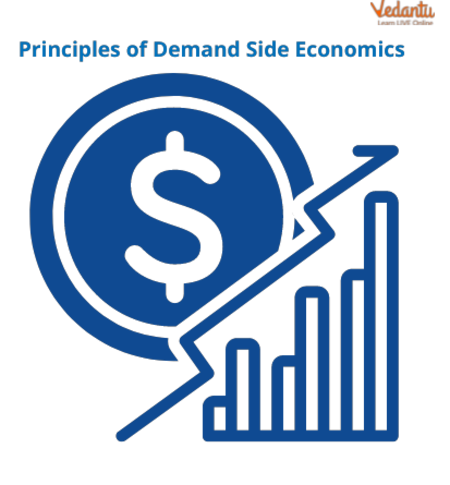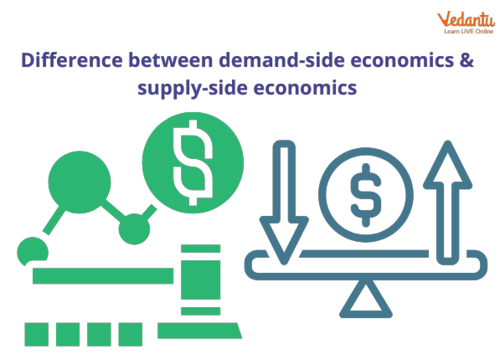




What is Demand Side Economics?
Demand-side economics is a school of economic thought that John Maynard Keynes established, arguing that economic growth is directly correlated with consumer demand for goods and services. This theory is also known as Keynesian economic theory. The demand for products and services, according to Keynesian economists, is what primarily drives economic activity and short-term fluctuations.
The emphasis on aggregate demand is one of the fundamental aspects of Keynesian economics or demand-side economics. Consumption of goods and services, industry investments in capital goods, governmental spending on public goods and services, and net exports comprise aggregate demand. Keynes emphasised that low demand for goods causes unemployment.
Demand Side Economics
Principles of Demand Side Economics

Principles of Demand Side Economics
The Keynesian explanation of how the economy functions are based on three main principles are as follows:
Prices, especially salaries, take time to adjust to changes in supply and demand, which frequently leads to labour shortages and surpluses.
Many economic decisions, both public and private, have an impact on aggregate demand. Private sector decisions can occasionally have a negative macroeconomic impact, such as a decrease in consumer spending during a recession. These market failures occasionally require active government actions, such as a fiscal stimulus package. Therefore, Keynesian economics favours a mixed economy run partly by the government and mainly under the direction of the private sector.
The immediate effects on real output and employment, not on the prices, resulting from changes in aggregate demand. However, it also includes a multiplier impact, when output varies by a factor of the change in spending (upward or downward) that created the change.
Difference Between Demand-side and Supply-side Economics

Difference Between Demand-side Economics and Supply-side Economics
Demand-side economics holds that consumers and their need for goods and services are the primary economic drivers, while it is not the same for supply-side economics. Let's have a look at a few differences between both of them:
Focus on Who Benefits From Tax Cuts: According to supply-side economics, tax relief is provided to corporations and the rich to encourage them to invest and fund business ventures. While demand-side economics focuses on giving tax cuts to lower- and middle-class people to encourage them to spend more on consumer products.
Emphasise Suppliers vs Consumers: Demand-side economics concentrates on the average consumer to support reviving the economy. On the other hand, the main goal of supply-side economics is to encourage prosperous consumer and company expenditure.
Give Customers More Options Rather Than More Money: Yet another way to distinguish between supply-side and demand-side economics is to consider the benefits they provide for customers. The objective of supply-side economics is to increase the number of goods and services available to consumers by encouraging companies to invest in production and research.
Demand-side economics, in comparison, is aimed at assisting consumers in increasing their income by lowering taxes so they can spend more on products and services.
Governmental Action: Demand-side economics emphasises the necessity and significance of public spending, infrastructure improvement, and new initiatives. On the contrary, supply-side economics places more of an emphasis on tax law. This is because reduced taxes encourage production, increasing commodity supply.
Summary
Supply and demand theory, or "comedian economics," is an approach that highlights the role that consumer demand plays in driving economic activity and generating variations. In contrast, producers' desire to deliver products and services determines supply-side economics. Monetary and fiscal policies are the two subcategories that make up demand-side policies. Variations in public spending and taxation are the primary concern of policymakers. Strategy for managing the money supply also includes measures to control the availability of credit and the cost of borrowing.
FAQs on Demand-Side Economics: Principles and Examples
1. What are the three essential policies of supply-side policies?
The three essential policies of supply-side economics are discussed below:
Tax Policy: Supply-side economics urges the government to lower taxes on corporations and the wealthy while redistributing tax burdens throughout the population.
Monetary Policy: To lower interest rates or reduce inflation, monetary policy may include raising the amount of money in circulation.
Regulatory Policy: The government enacts regulations to provide companies more freedom in areas like foreign trade, unemployment insurance, and other things that would be more expensive with stricter controls.
2. What are the three examples of Keynesian economics?
To preserve current employment and generate new ones, President Obama signed the $831 billion American Recovery and Reinvestment Act in 2009. It also featured family unemployment benefits, tax breaks, and spending allocations for infrastructure, education, and healthcare.
Following the COVID-19 pandemic of 2020, the American government, led by Presidents Donald Trump and Joseph Biden, provided assistance, loan forgiveness, and loan extension programmes.
The Keynesian notion that even a free-enterprise capitalist system needs some governmental monitoring was explicitly represented in the New Deal, a set of government measures that President Franklin Roosevelt implemented to alleviate the crisis in the United States during the Great Depression.
3. Who introduced Keynesian economics?
English economist John Maynard Keynes rose to prominence in the 1930s with his demand-side macroeconomic theory. Keynesian economics is the term coined for his theories. During the Great Depression, he supported policies of more government spending and reduced taxation to increase demand for products and services. Keynes argued that low demand for commodities is what causes unemployment. For example, production halted at factories during the Great Depression. Insufficient product demand left factories with little need for labour.





















